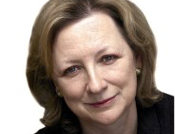Carla Carlisle on a Christmas miracle
Carla Carlisle remembers an advent calendar which changed her life


I don't believe it would be overly dramatic to say that my life was changed by an Advent calendar. The year was 1979, and it was my first-ever Advent calendar. I bought it in the Habitat on the King's Road and it was predictable Habitat: non-sectarian good taste. I was living in Paris at the time, in an artist's atelier behind Montparnasse, and my life was like an ENO production of La bohème set in the late 1970s.
Trips to London-an eight-hour journey in those days always included an evening at the theatre, a lunch at Cranks, dinner at the Star of India in South Kensington, and shopping: Peter Jones, Laura Ashley, John Sandoe's and Habitat, because everything was so much cheaper than in Paris.
Back to the Advent calendar. It was a triptych, which opened to reveal the interior of a house on Christmas Day. Downstairs in the kitchen, still in her dressing gown, the mother is lifting a turkey out of the oven. Cream Aga, of course. Behind her, the dog stretches in his basket. On the painted dresser, platters and teapots. On the pine table, a tray of mince pies and two glasses of red wine.
Upstairs, the father, still in pyjamas, sits on the edge of the four-poster bed holding the new baby. At his feet, a Moses basket. And making their way down the stairs, two little girls, gazing at the Christmas tree surrounded by presents. Fire in the fireplace, books on bookshelves, hi-fi with one of those clear plastic covers over the turntable. Bows of ivy over the pictures. A wicker log basket. I could go on, but you get the picture. Home. Familial bliss. Married life. Real furniture. Nice stuff. Good children.
You may wonder why I have such vivid recall of an Advent calendar that goes back 30 years. Two reasons. That Advent calendar became a kind of icon for me. Suddenly, my liberated and nomadic life seemed as bleak and vast as the Moon. Diatribes about marriage as an oppressive institution suddenly sounded like a script from a dated play.
As I studied the rooms in the Advent house, I felt an admiration for people who, despite the trembling uncertainty of life, wanted to create a home, plant trees, breed babies. Instead of seeing the nuclear family as suffocating, it felt like an affirmation of life. The pictures spoke to me of the tender optimism of the human condition.
But from my Damascene revelation-that home and family are fertile fields for nurturing the kind of faith in the ultimate goodness of man that gives us our inner security-to the moment when, in my dressing gown, stepping over the dog to hoist a turkey from the Aga, spilling turkey grease on new slippers while the husband cradles the baby and reads P. G. Wodehouse at the same time, between the concept and the fulfilment, there was a long wait. Ten years.
Sign up for the Country Life Newsletter
Exquisite houses, the beauty of Nature, and how to get the most from your life, straight to your inbox.
But waiting is what Advent is about. Waiting, as Ronald Blythe puts it, for the human child who is ‘to become one of us to show us what we could be, what we should be'. The year I bought the Advent calendar on the King's Road, I was, to be honest, more interested in Beckett's Waiting for Godot than I was in the solemn countdown to the birth of a child in a manger.
The words of the Advent collect which entreats God to ‘give us grace that we may cast away the works of darkness' were still in my memory, but a calendar with a tender-eyed donkey and a babe in swaddling clothes wouldn't have changed my life in those days.
The other reason I'm able to describe the Habitat Advent calendar is that it's taped permanently to the back door of the larder. Like icons of old, it's there to remind me of its place in the life I have. I have other Advent calendars, including a much-loved collection by Matthew Rice, but this is the one that brought me to Wyken and to this back page. The Habitat Advent. The King's Road. A miracle, actually.
Country Life is unlike any other magazine: the only glossy weekly on the newsstand and the only magazine that has been guest-edited by HRH The King not once, but twice. It is a celebration of modern rural life and all its diverse joys and pleasures — that was first published in Queen Victoria's Diamond Jubilee year. Our eclectic mixture of witty and informative content — from the most up-to-date property news and commentary and a coveted glimpse inside some of the UK's best houses and gardens, to gardening, the arts and interior design, written by experts in their field — still cannot be found in print or online, anywhere else.
-
 380 acres and 90 bedrooms on the £25m private island being sold by one of Britain's top music producers
380 acres and 90 bedrooms on the £25m private island being sold by one of Britain's top music producersStormzy, Rihanna and the Rolling Stones are just a part of the story at Osea Island, a dot on the map in the seas off Essex.
By Lotte Brundle
-
 'A delicious chance to step back in time and bask in the best of Britain': An insider's guide to The Season
'A delicious chance to step back in time and bask in the best of Britain': An insider's guide to The SeasonHere's how to navigate this summer's top events in style, from those who know best.
By Madeleine Silver